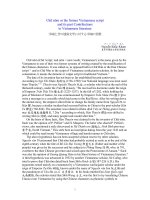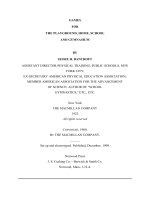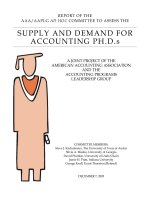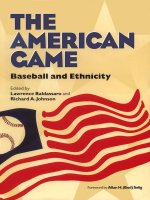The American Game BASEBALL AND ETHNICITY potx
Bạn đang xem bản rút gọn của tài liệu. Xem và tải ngay bản đầy đủ của tài liệu tại đây (18.43 MB, 233 trang )
THE
SOUTHERN
ILLINOIS
UNIVERSITY
PRESS SERIES
Other
Books
in the
Writing
Baseball
Series
Man on
Spikes
Eliot
Asinof
Foreword
by
Marvin
Miller
Off-Season
Eliot
Asinof
The
Chicago
Cubs
Warren
Brown
Foreword
by
Jerome
Holtzman
My
Baseball Diary
James
T.
Farrell
Foreword
by
Joseph
Durso
The
Brooklyn Dodgers:
An
Informal History
Frank
Graham
Foreword
by
Jack
Lang
The New
York Giants:
An
Informal
History
of a
Great Baseball Club
Frank
Graham
Foreword
by Ray
Robinson
The
New
York Yankees:
An
Informal History
Frank
Graham
Foreword
by
Leonard
Koppett
The
Best
Seat
in
Baseball,
But
You
Have
to
Stand!
The
Game
as
Umpires
See It
Lee
Gutkind
Foreword
by
Eric Rolfe
Greenberg
Line
Drives:
100
Contemporary Baseball
Poems
Edited
by
Brooke
Horvath
and
Tim
Wiles
Foreword
by
Elinor
Nauen
Full
Count
Inside Cuban Baseball
Milton
H.Jamail
Foreword
by
Larry
Dierker
Owning
a
Piece
of the
Minors
Jerry
Klinkowitz
Foreword
by
Mike
Veeck
The
St
Louis
Cardinals:
The
Story
of a
Great Baseball Club
Frederick
G.
Lieb
Foreword
by Bob
Broeg
The
National Game
Alfred
H.
Spink
Foreword
by
Steven
P.
Gietschier
The
American
Game
This page intentionally left blank
THE
AMERICAN
*GAME*
BASEBALL
AND
ETHNICITY
EDITED
BY
Lawrence
Baldassaro
AND
Richard
A.
Johnson
WITH
A
FOREWORD
BY
Allan
H.
(Bud) Selig
Southern
Illinois University Press
Cctrbondale
and
Edivardsville
Copyright
©
2002
by the
Board
of
Trustees,
Southern Illinois University
All
rights reserved
Printed
in the
United States
of
America
05 04 03 02 4 3 2 1
Chapter
4
originally appeared
in New
Perspectives
on the
Irish Diaspora,
ed.
Charles Fanning
(Carbondale:
Southern Illinois University Press,
2000),
176-85
©
2000
by the
Board
of
Trustees,
Southern
Illinois University.
A
slightly
different
version
of
chapter
5
originally appeared
in
Past Time:
Baseball
Across
the
Decades,
by
Jules Tygiel, copyright
2000
by
Jules Tygiel.
Used
by
permission
of
Oxford University Press, Inc.
A
portion
of
chapter
6
previously appeared
in "Ed
Abbaticchio:
Italian
Baseball
Pioneer,"
NINE:
A
Journal
of
Baseball
History
and
Social
Policy
Perspectives,
8
(fall
1999):
18-30.
Library
of
Congress Cataloging-in-Publication Data
The
American game
:
baseball
and
ethnicity
/
edited
by
Lawrence
Baldassaro
and
Richard
A.
Johnson
;
with
a
foreword
by
Allan
H.
(Bud)
Selig.
p. cm.
Includes bibliographical references
and
index.
1.
Baseball—Social aspects—United
States.
2.
Ethnicity—
United States.
I.
Baldassaro, Lawrence.
II.
Johnson, Dick, 1955-
GV867.64
.A44 2002
796.357—dc21
2001049600
ISBN
0-8093-2445-8
(alk. paper)
ISBN
0-8093-2446-6 (pbk.
:
alk. paper)
The
paper used
in
this
publication meets
the
minimum requirements
of
American
Na-
tional
Standard
for
Information Sciences—Permanence
of
Paper
for
Printed Library
Materials, ANSI
Z39.48-1992.
©
Writing
Baseball Series Editor:
Richard
Peterson
To
the
memory
of my
parents,
Gerald
and
Olive Baldassaro,
who
instilled
in me a
love
of
the
game,
and to my
son, Jim,
who
carries
on the
challenging
tradition
of
rooting
for the Red
Sox.
—L. B.
To
the
memory
of my
father,
Dr.
Robert
Andrew
Johnson
(1914-2001):
physician, soldier,
scholar,
father,
and
friend.
-R. J.
This page intentionally left blank
Contents
List
of
Illustrations
xi
Foreword
by
ALLAN
H.
(BUD)
SELIG
xiii
Acknowledgments
xv
1.
Introduction
1
LAWRENCE
BALDASSARO
2. The
Many Fathers
of
Baseball: Anglo-Americans
and
the
Early Game
6
FREDERICK
IVOR-CAMPBELL
3.
German Americans
in
Major League Baseball: Sport
and
Acculturation
27
LARRY
R.
GERLACH
4.
"Slide,
Kelly,
Slide":
The
Irish
in
American Baseball
55
RICHARD
F.
PETERSON
5.
Unreconciled Strivings: Baseball
in Jim
Crow America
68
JULES
TYGIEL
6.
Before
Joe D:
Early Italian Americans
in the
Major Leagues
92
LAWRENCE
BALDASSARO
7.
From Pike
to
Green with Greenberg
in
Between:
Jewish
Americans
and the
National Pastime
116
STEVEN
A.
RIESS
8.
Diamonds
out of the
Coal Mines: Slavic Americans
in
Baseball
142
NEAL
PEASE
ix
x
CONTENTS
9. The
Latin
Quarter
in the
Major Leagues: Adjustment
and
Achievement
162
SAMUEL
O.
REGALADO
10.
Baseball
and
Racism's Traveling
Eye:
The
Asian
Pacific
American Experience
17
JOEL
S.
FRANKS
Contributors
199
Index
201
Illustrations
Albert Goodwill Spalding
8
Henry Chadwick
14
Honus Wagner
34
George Herman "Babe" Ruth
44
Charlie
Gehringer
46
John McGraw
61
Connie
Mack with Mickey Cochrane
and
Lefty
Grove
63
Willie
Mays
72
Jackie
Robinson with teammates
86
Ed
Abbaticchio
94
Tony Lazzeri
103
Joe
DiMaggio surrounded
by
adoring
fans
110
Hank Greenberg
128
Sandy
Koufax
132
Stan
"the Man" Musial
151
Carl
Yastrzemski
as a Red Sox
rookie
157
Miguel
Angel
"Mike"
Gonzalez
165
Saturnino
Orestes Arrieta Armas
"Minnie"
Minoso
168
Roberto Clemente
171
Mike
Lum 192
Wendell
Kim 193
This page intentionally left blank
Foreword
ALLAN
H.
(BUD) SELIG
On 15
April
1997,
at
Shea Stadium
in New
York,
Major League Baseball
honored
the
great Jackie Robinson
by
celebrating
the fiftieth
anniversary
of
his
historic entry
into
the big
leagues.
At
that
time,
I
said,
"The
day
Jackie
Robinson stepped
on a
major league
field
will
forever be
remem-
bered
as
baseball's
proudest
moment."
Jackie's
achievement,
so
ably assisted
by
Branch Rickey,
was a
seminal
event
not
only
for
baseball
but
also
for the
entire country.
For the first
time, baseball, long hailed
as our
national pastime, truly became
the
game
that
represented
all of
America.
Throughout
the
early days
of its
history, baseball
had
attracted
im-
migrants
and
members
of
diverse ethnic groups.
For
some,
it was a way
out of the
ghetto;
for
others,
it was a
pleasant diversion from
a
difficult
existence;
and,
for
many,
the
game provided
a
measure
of
acceptance,
a
platform
on
which
one
could stand proudly
and
proclaim
his
status
as an
American.
The
American Game:
Baseball
and
Ethnicity describes baseball's role
in
the
evolving ethnic changes
that
took
place
in
America beginning with
the
Anglo-Americans,
who
contributed
to the
formation
of the
game
a
century
and a
half ago.
In
separate essays,
the
book examines
the
roles
of
various
European ethnic groups
as
their members entered
the
game
be-
ginning
in the
latter part
of the
nineteenth century
and
continuing
though
the
middle
of the
twentieth. They
and
their forebears came
from
Germany,
Ireland, Italy, Poland, Czechoslovakia,
and
other
Slavic
nations.
Some
were Christians; some were Jews.
As a
whole,
the
ethnic repre-
sentation
in
baseball
was
presented publicly
as a
metaphor
for
America's
melting
pot.
In
truth,
it was not
quite
the
melting
pot it was
supposed
to be. In
his
essay
"Unreconciled Strivings:
Baseball
in Jim
Crow America,"
Jules
Tygiei
examines
how
African
Americans were excluded
from
baseball
as
they
were from other aspects
of
American
life.
Baseball certainly regrets
its
role
in the
exclusion
of
African
Americans
for
most
of its
early
history,
xiii
xiv
FOREWORD
but it is
proud that
the
breaking
of
baseball's color barrier took
place
before
the
integration
of
other American institutions.
Today, baseball truly
is a
melting
pot and
reflects
the
evolving
Ameri-
can
population
as
well
as or
better than
any
other
sport
or
enterprise.
In
fact,
with each year, more
and
more
of our
players come
from
foreign
countries, notably
the
great talent that
has
come
from
the
Caribbean
and
Latin
America.
At the
start
of the
2000
Major League
Baseball
season,
198
players, nearly
24
percent
of all
players
on
major
league rosters, were
born outside
the fifty
states. They represented sixteen
different
foreign
countries
and
Puerto Rico.
The
small
Caribbean nation
of the
Dominican Republic
had the
most
players
with seventy-one, followed
by
Puerto Rico with thirty-three
and
Venezuela
with thirty-one.
Other
nations represented were Aruba (three
players),
Australia (one), Canada (twelve), Colombia (two), Cuba
(nine),
Curacao (one), Great Britain (one), Jamaica (one), Japan
(six),
Korea
(three), Mexico (fourteen), Nicaragua (one), Panama (eight),
and the
Virgin
Islands (one).
Because
of
this
great
influx
of
foreign
talent
and the
growing
interest
in
the
sport around
the
world, Major League
Baseball
has
embarked
on
an
international strategy that will bring
the
game
to
peoples
of
various
races
and
ethnic groups
in all
parts
of the
globe.
In
some respects, this
strategy
is the
opposite
of the
phenomenon that took place during
the
game's
first one
hundred years, when
different
ethnic groups brought
their
influence
to
baseball. This international strategy
will
assure
for de-
cades
to
come that
baseball
will
continue
to be
diverse
and
inclusive
of
all
peoples
and
nationalities.
Acknowledgments
The
editors wish
to
express their gratitude
to the
contributors whose
essays
made
this
collection possible
and to
Allan
H.
(Bud) Selig,
who
remains
first and
foremost
a fan of the
game.
A
special
note
of
thanks
to
Richard Peterson, general
editor
of the
Writing
Baseball series,
for first
suggesting this volume
and to our
edi-
tors,
Karl
Kageff,
Carol Burns,
and
Robin DuBlanc,
for
their patient
and
knowledgeable guidance.
As
always,
Pat
Kelly
and
Bill
Burdick
of the
National Baseball Hall
of
Fame were both generous
and
expeditious
in
providing photos.
This page intentionally left blank
The
American
Game
This page intentionally left blank
* 1 *
Introduction
LAWRENCE
BALDASSARO
Ever
since athletes
of
German
and
Irish descent entered
the
major
leagues
in
large numbers more than
a
century ago,
the
ethnic background
of
baseball
players
has
fascinated
fans
and the
media. Even before
the
turn
of the
century, major league teams were courting ethnic
fans.
In St.
Louis,
ads
were placed
in
German-language newspapers.
In the
Polo
Grounds,
the
section
of the
bleachers where Irish
fans
gathered
was
known
as
Burkeville,
and in
other parks, Irish
fans
sat in
"Kerry Patches."
Beginning
in the
1880s, ethnic tensions heightened
as
successive
waves
of new
immigrants
from
southern
and
eastern Europe moved into
big-city
neighborhoods previously settled
by
earlier generations
of
new-
comers. Cultures inevitably clashed;
the
"old" immigrants resented
the
new
arrivals,
not
only
for
encroaching
on
their territory
but for
threaten-
ing to
take away their jobs. Boxing promoters openly exploited these ten-
sions
by
setting
up
bouts
in
which Irish, Italian,
and
Jewish
fighters
were
pitted against each other.
For
professional baseball,
the new
immigrants meant potential
new
customers.
One way to tap
into
this market
was to put
"ethnic"
heroes
on the field. In the
1920s,
commentators
noted
the
influx
of
players
of
Italian
and
Slavic
origins
and
wondered
why
there weren't more Jewish
players
in the big
leagues. However,
it
wasn't until
the
mid-thirties that
representatives
of the new
European
immigrants—primarily
Italians
and
1
2
LAWRENCE
BALDASSARO
Slavs—appeared
in the big
leagues
in
numbers that approached their pro-
portion
of the
total population.
The era following
World
War II saw the
most dramatic ethnographic
shift
with
the
belated entry
of
African
American
ballplayers.
The
pattern
of
ethnic succession continues,
as
players
of
Hispanic
and
Asian
origin provide
a new
infusion
of
excitement
and
renewal into
America's game, from
Fernando
Valenzuela
in the
eighties
to
Hideo
Nomo
in the
nineties
to
Ichiro Suzuki
in
2001.
Peter Gammons noted
in a
Boston
Globe
column
in
1998
that,
for
many, "baseball
is the
sport
of the two
fastest-rising socioeconomic groups, Hispanics
and
Asian-
Americans."
1
Anyone
who has
witnessed
the
Japanese media throngs cov-
ering
Nomo
and
Suzuki
and the
national celebrations
of
Dominican
fans
cheering
Sammy
Sosa's
heroics
is
inclined
to
agree.
The
1998
home
run
race between Sosa
and
Mark McGwire provided
a
vivid reminder
of the
racial
and
ethnic dimension
of
baseball history.
In the
process
of
shadowing McGwire, Sosa became
a
national hero, both
to
Dominicans living
in his
native land
and
those
in the
United States.
He
also became
the
standard bearer
for all
Hispanic ballplayers,
a
symbol
of
their growing impact
on the
game. Meanwhile, some commentators
speculated that McGwire's broad base
of fan
support
was
due,
in
part,
to
his
all-American
image;
he is, as one
columnist called him,
"a
white
guy
of
Irish
ancestry.""
(There
was a
time,
of
course, when someone
of
Irish
descent
was not a
likely
candidate
for
prototypical
American.)
The
demographics
of big
league baseball
are
shifting
in yet
another
way.
The
game long
ago
spread
far
beyond U.S. borders,
but
major
leagu-
ers
were almost exclusively American-born descendants
of
immigrants.
Now, increasing numbers
of
foreign-born players
are
making
it to the
major
leagues.
On
opening
day of the
2001 season, 25.3 percent
of the
players
on the
major league forty-man
rosters
and 45
percent
of
minor
league
players were born outside
the
United States.
Those
players
came
from
twenty-seven
different
countries around
the
globe. Accordingly,
major
league games were telecast
to
more than
two
hundred countries
in
2001.
The
international
flavor of
American baseball
was
strikingly
evident
in
the
pitching staff
of the
1998
New
York
Yankees, winners
of the
World
Series
and
considered
by
many
one of the
best teams ever.
In
addition
to
native-born Americans,
the
staff included Graeme Lloyd
from
Australia,
Hideki Irabu from Japan, Orlando
"El
Duque"
Hernandez from Cuba,
and
Ramiro Mendoza
and
Mariano
Rivera
from
Panama.
When,
near
the
Introduction
3
end
of the
1998 season, late-night talk show
host
David Letterman
an-
nounced
his
"Top
Ten
Signs
the New
York
Yankees
are
Getting
Arro-
gant,"
the
number
one
item
on the
list
was: "Sometimes they
let an
American
guy
pitch."
Of our
major
sports, only baseball
has
generated this fascination with
ethnicity,
presumably because baseball
has
long been
associated
with
"American"
values. Early
in
the
twentieth century, baseball, already
well
established
as the
national pastime,
was
being hailed
as a
metaphor
of the
American
melting pot, welcoming,
in
turn,
a
succession
of
ethnic
groups.
In
America's
National
Game,
published
in
1911,
A. G.
Spalding
insisted
on the
democratic nature
of
baseball, alluding
to
what would
have
passed
at
the
time
as the
game's ethnic
inclusiveness
by
writing: "The
son of a
President
of the
United States would
as
soon play with Patsy Flannigan
as
with Lawrence Lionel Livingstone, provided only that
Patsy
could
put
up the
right
article.""
Journalists
pointed
out the
beneficial
role
of
baseball
as a
means
of
acculturating
the
children
of
immigrants
by
instilling
the
American ide-
als
of
democracy
and
fair
play.
In the
18
July
1919
issue
of the
Atlanta
Constitution, sportswriter
Hugh
Fullerton
wrote: "Baseball,
to my way of
thinking,
is the
greatest single force working
for
Americanization.
No
other game appeals
so
much
to the
foreign-born youngsters
and
nothing,
not
even
the
schools, teaches
the
American spirit
so
quickly."
Similar
thoughts were expressed
in
1923
by
Frederick
G.
Lieb,
presi-
dent
of the
Baseball
Writers' Association,
in an
article
titled
"Baseball-—
The
Nation's Melting Pot." Lieb concluded
that
"next
to the
little
red
school house, there
has
been
no
greater agency
in
bringing
our
different
races
together
than
our
national game, baseball. Baseball
is our
real
melt-
ing
pot."
(Lieb
was
referring,
of
course,
not to
races
but to
ethnic
groups.
The
real racial issue,
the
exclusion
of
African
Americans
from
organized
baseball,
was
simply
not a
topic
of
discussion
at the
time.)
In
that same article, Lieb attempted,
as
many others
would
as
well,
to
associate particular aptitudes with
specific
ethnic groups: "Slugging
strength seems
to be
characteristic
of the
German element
in
professional
baseball,
while
the
Irish players usually
are
faster
and
think
quicker.
"
n
Later
commentators, reflecting widely accepted ethnic stereotypes, would
characterize
Italians
as
best suited
to be
catchers (because
of
their
short,
stocky
builds),
Slavs
as
muscular
sluggers,
and
Jews
as
brainy
ballplayers.
At
times
the
expression
of
baseball's open arms policy
was
couched
in
language that
now
sounds
like
self-parody.
In
1923,
for
example,
The
4
LAWRENCE
BALDASSARO
Sporting
News
proudly proclaimed that "the Mick,
the
Sheeny,
the
Wop,
the
Dutch
and the
Chink,
the
Cuban,
the
Indian,
the Jap or the
so-called
Anglo-Saxon—his
'nationality'
is
never
a
matter
of
moment
if
he
can
pitch, hit,
or field.""
Baseball's professed
indifference
to the
ethnic back-
ground
of its
players
(with
the
obvious exception
of
blacks)
was a re-
minder
of its
role
as a
symbol
of the
American melting pot;
all
were
welcome
to
participate
in the
great democratic
ideal
with
its
promise
of
equal
access
to the
American Dream.
The
melting
pot
theory
has
fallen
out of
favor
with many.
Its
sugges-
tion
of a
cauldron
in
which ethnic
differences
are
fused
into
a
homoge-
neous amalgam
does
not sit
well
in a
postmodern
culture.
The
metaphor
of a
mosaic,
or a
quilt,
is now
seen
as a
more appropriate expression
of a
multicultural
society that,
in
theory
at
least, respects
and
retains ethnic
differences.
Several
of the
essays
in
this book suggest that baseball,
in
fact,
embraces
both
of
these metaphors.
On the one
hand, individual
he-
roes have provided positive role models
and
helped foster
a
sense
of
pride
and
cohesion
within their ethnic communities, with
the
subsequent
po-
tential
for
continued isolation
from
the
larger community.
At the
same
time,
participation
in
baseball, either
as
player
or
fan,
has
provided
a way
for
many
to
assimilate
into
American society.
Regardless
of the
metaphor
of the
moment, melting
pot or
mosaic,
there
is no
question that baseball, more than
any
other
sport
and
more
than
most
American social institutions,
has
mirrored
the
gradual
and
often
difficult
process
of
assimilation experienced
by a
succession
of
eth-
nic
and
racial
groups
over
the
course
of the
twentieth century.
For
much
of the first
half
of the
century,
baseball
provided
a
window
on the
Ameri-
can
Dream, creating
in
second-generation youth,
especially
those
of
European heritage,
an
awareness
of
those
ideals
that
the
arbiters
of
main-
stream
culture
identified
as
"American"
and
serving
as a
bridge between
the
customs
of
their immigrant parents
and the
world they
found
outside
the
home.
With
the
exception
of the first,
each
of the
essays
in
this collection
documents some form
of
discrimination,
from
verbal slurs
to
outright
banishment
in the
case
of
African Americans.
At the
same time,
for
that
small
percentage
of
individuals blessed with great
skill,
the
game
offered
a
shortcut
to financial
reward
and
social status.
Their
success,
in
turn,
instilled
pride
in
their respective ethnic communities
and
offered
hope
that others might also
prosper
in
America.
And
even
for
those
whose
talent
never took them
bevond
sandlot
baseball
but who
learned
and
fol-
Introduction
5
lowed
the
game, baseball, which remained undisputed
as the
American
game
for
much
of the
twentieth century, provided
a
passport
to at
least
a
part
of
mainstream American culture, making them more recognizably
"American"
and
less foreign. Even
for
African
Americans, whose
system-
atic
exclusion from major league baseball overshadows
the
obstacles
faced
by
all
others
who
hoped
to
play
professionally, baseball ultimately pro-
vided
the first
official
avenue
of
integration.
Ever
since
Harold
Seymour's groundbreaking study
first
appeared
in
1960, students
of the
game have explored
the
ways
in
which baseball
history mirrors
the
larger patterns
of
American
life.
The
ethnic
and
racial
dimension
of
major league baseball
has
been
one of the
more
fertile
grounds
for
study
in
recent years.
The
American Game brings together
in
one
volume
a
variety
of
perspectives
on
this important aspect
of
baseball
history. While this collection
is
obviously representative
and not
exhaus
tive
in
scope,
its
goal
is to
demonstrate
how the
gradual involvement
by
various
ethnic
and
racial groups
reflects
the
changing nature
of
baseball,
and
of
American society
as a
whole, over
the
course
of the
twentieth
century.
These essays
may
also serve
as a
reminder that
the
history
of
baseball,
like
the
history
of
this
nation,
consists
of the
contributions
made
by
individuals
from
virtually every group that
has
made
its way to
these shores.
Notes
1.
Peter
Gammons, "Two
Men Who
Exceed
Their
Numbers,"
Boston
Globe
Online,
5
September 1998.
2.
Leonard
Pitts,
"We
Like Sosa,
but We
Love
McGwire,"
Milwaukee
Jour-
nal,
4
October,
1998,
4J.
3.
Albert
G.
Spalding,
America's National Game
(1911;
reprint, Lincoln:
University
of
Nebraska Press,
1992),
6.
4.
Frederick
G.
Lieb,
"Baseball—The
Nation's
Melting Pot," Baseball Maga-
zine
31
(August 1923): 393.
5.
Lieb, 394.
6. The
Sporting
News,
6
December
1923,
4.
*2*
The
Many Fathers
of
Baseball:
Anglo-Americans
and the
Early Game
FREDERICK
I V O R - C A M P B E L L
Writer
Henry Chadwick probably struck close
to the
mark
in his
intuitive
insistence that baseball derived from
the
English game
of
rounders.
Two
arguments have been made
that
baseball
was
invented
ex
nihilo.
The
most
familiar,
the
story that West Point cadet Abner
Doubleday
invented
the
game
in
Cooperstown
in
1839,
has
been
thoroughly
discredited
on
sev-
eral
grounds,
not
least
of
which
is
that Abner Graves,
who
came
up
with
the
story, never said that Doubleday invented
the
game
out of his own
head,
but
only that
he saw
Doubleday outline
a
diamond
on the field, and
later
on
paper,
"with
a
crude pencil memorandum
of the
rules
for his new
game,
which
he
named
'Base
Ball.'"
1
The
second argument
for ex
nihilo creation comes
from
a
purported
statement
by the first
Knickerbocker Club
president,
Duncan Curry, that
Alexander
Cartwright "came
up to the
ball
field
with
a new
scheme
for
playing
ball"
and
presented
it to
ballplaying
friends
who up to
that time
had
simply "batted
the
ball
to one
another
or
sometimes played
one
o'cat."
But
writer William Rankin,
who
issued Curry's statement
in
1910,
had
written
it
from
his
memory
of a
street corner conversation over
three decades earlier
at
which
he had
taken
no
notes except "Mr.
Alex.
Cartwright
is the
father
of
base
ball."
2
Our
earliest description
of the
origins
of the
Knickerbocker Club, Charles
A.
Peverelly's
brief club his-
tory
in The
Book
of
American
Pastimes,
says
of
Cartwright's
contribution
6









